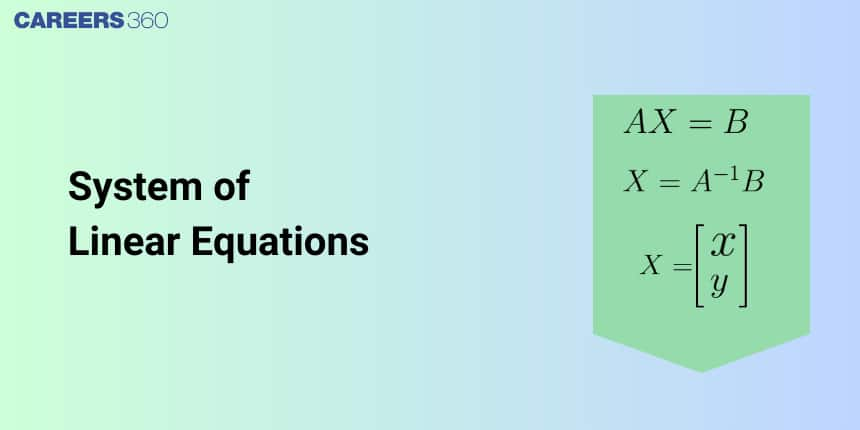System of Linear Equations
In mathematics, a system of linear equations, also known as a linear system, consists of one or more linear equations that involve the same set of variables. There are many methods by which we can solve the system of linear equations. In real life, we use the system of linear equations to solve age-related problems and time-related problems.
JEE Main: Study Materials | High Scoring Topics | Preparation Guide
JEE Main: Syllabus | Sample Papers | Mock Tests | PYQs
- System of Linear Equation
- Consistent system of equations:
- Inconsistent equation:
- Homogenous System of Linear Equation
- Non Homogenous System of Linear Equations
- Methods to solve Systems of Linear Equations in two variables
- Methods to solve Systems of Linear Equations in three variables
- Solved Examples Based on System of Linear Equations

In this article, we will cover the concept System of linear equations. This category falls under the broader category of Matrices, which is a crucial Chapter in class 12 Mathematics. It is not only essential for board exams but also for competitive exams like the Joint Entrance Examination(JEE Main) and other entrance exams such as SRMJEE, BITSAT, WBJEE, BCECE, and more. Questions based on this topic have been asked frequently in JEE Mains
System of Linear Equation
A system of linear equations are group of
1. System of 2 Linear Equations:
It is a pair of linear equations in two variables. It is usually of the form
Finding a solution for this system means finding the values of
2. System of 3 Linear Equations:
It is a group of 3 linear equations in three variables. It is usually of the form
Finding a solution for this system means finding the values of
The system of equations is broadly classified into two types:
Consistent system of equations:
A system of equations is said to be consistent if it has at least one solution. Let the given system of equations is
Given lines are non-parallel, hence lines will have one point of intersection.
In this case, two lines represented by these lines coincide, so there are infinite pair of values of
Inconsistent equation:
A system of equations is said to be inconsistent if it has no solution.
For example,
Homogenous System of Linear Equation
A linear equation with a constant value of zero is called a homogeneous equation.
Note that
Also, the solution
- If
- If
Non Homogenous System of Linear Equations
A linear equation with a constant value not equal to zero is called a homogeneous equation.
Characteristics of non Homogenous Linear Equations
- If
- If
- If
Methods to solve Systems of Linear Equations in two variables
We use the following method to solve a System of linear equations in two variables
- Graphical method
- Elimination method
- Substitution method
- Matrix method
- Cross Multiplication method
Methods to solve Systems of Linear Equations in three variables
We use the following method to solve a System of linear equations in three variables
- Cramers Rule
- Inverse method
- Gaussian elimination method
- Gaussian Jordan method
- LU Decomposition method
Recommended Video Based on System of Linear Equations:
Solved Examples Based on System of Linear Equations
Example 1:
Let the system of linear equations
has a unique solution
Solution
Hence, the answer is 3.
Example 2: Let N denote the number that turns up when a fair die is rolled. If the probability that the system of equations
has a unique solution is
Solution
For unique solution
Hence, the answer is 20.
Example 3:
If the system of equations
has infinitely many solutions, then
Solution
Hence, the answer is 916.
Example 4 :
Let
is inconsistent, then
[JEE MAINS 2023]
Solution
Given system of equations is inconsistent
But for
Then
Hence, the answer is 6.
Example 5: If the system of linear equations
has infinitely many solutions, then
[JEE MAINS 2023]
Solution
Condition of Infinite Many solutions
check.
After solving we get
Hence, the answer is 4.
Frequently Asked Questions (FAQs)
A system of linear equations are group of
A linear equation with a constant value not equal to zero is called a homogeneous equation.
A system of equations is said to be inconsistent if it has no solution.
Let
If
Then the system of equations is inconsistent and hence no solution exists.
Also Read
15 Feb'25 10:35 AM
14 Feb'25 01:24 PM
14 Feb'25 01:19 PM
14 Feb'25 01:11 PM
14 Feb'25 01:08 PM
14 Feb'25 01:01 PM
14 Feb'25 12:51 PM
14 Feb'25 12:48 PM
23 Sep'24 07:19 PM

